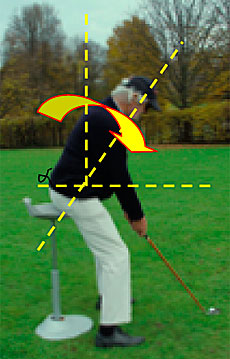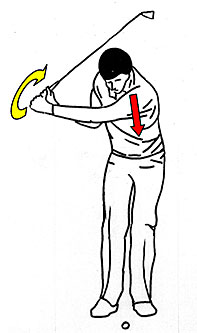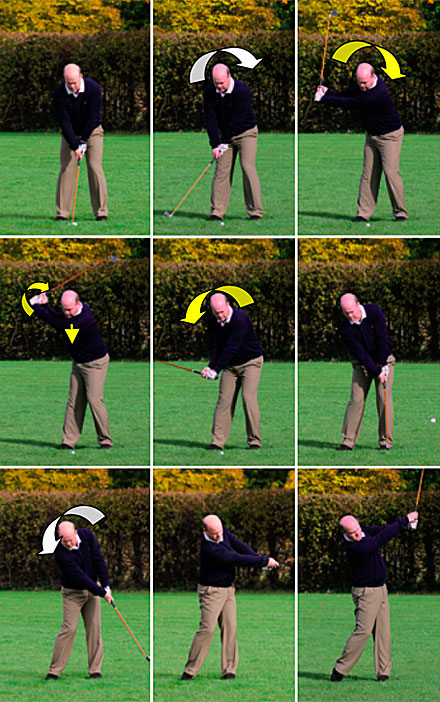The idea of simplifying the
golf game by using clubs of equal shaft lengths and applying
a unified swing technique led to the isolation of the pendulum
dynamics from the active body rotation. Both elements of movement
stand in relation to one another. The golf swing is composed
of numerous partial movements. This complex system as a whole
cannot be easily coordinated. CARVINGGOLF, however, does define
core movements, which make such a systematic training of movement
possible.
The arms swing to and fro
from the shoulder and the club swings to and fro at the wrist.
This pendulum motion presents a complex system which has to
be coordinated. Using the law of gravitation, one normally
leaves this coordination up to the natural forces, relying
upon the physics of pendulum dynamics. Nevertheless, the player
has to create the prerequisites for optimal rhythmic, geometric
and dynamic conditions of the swing process.
CORE MOVEMENTS OF GEOMETRIC
CONDITIONS
The arm-club pendulum motion forms the dynamic system of the
swing process, whereby the player’s body theoretically
represents the static system The dynamic pendulum motion system
can only function at an optimum if it is not disturbed, practically
meaning, the player has to set free the space for the pendulum
motion.
This happens through bending the upper body (fig. 2) and moving
the shoulder axis in such a manner as to allow, during the
upswing, the left shoulder and during the follow through the
right shoulder to tilt forward. Bending and tilting movements
of the upper body, made in order to stabilize the static system,
are core movements that optimize geometric conditions within
the swing process.
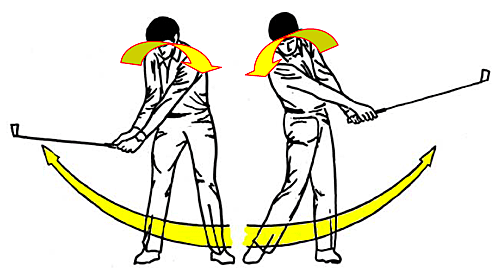 |
| fig. 1:
Bending and tilting the upper body sets the pendulum free
for the full swing. |
|
fig. 2: Bending the
upper body a little more, creates optimal geometric
conditions for the arm-club pendulum motion. Using the Swopper (a training
assistant), helps.
|
|
CORE MOVEMENTS OF DYNAMIC CONDITIONS
The arm-club pendulum motion forms a dynamic system The theoretical
suspension of this pendulum chain is the shoulder joint axis.
In practice, this axis joins both shoulder joints. During the
upswing, both shoulders are liftet up to the point of release,
thereby creating tension in both broad back muscles. During
the reversal of the swing, one uses this muscular tension and
both shoulders drop down. The hereby created vertical impulse
accelerates the system of pendulum motion.
Movements which develop tension in the back muscles are core
movements that optimize dynamic conditions within the swing
process.
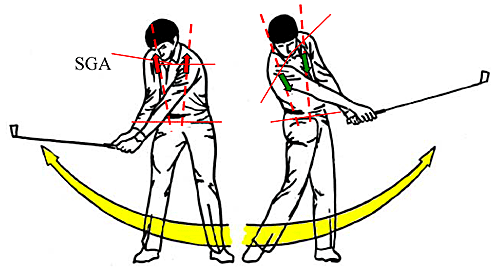 |
fig. 3: The
pendulum motion approach during the backswing and the
follow through,
triggered and controlled through an up and down movement
of the shoulder. |
LEGENDE:
| red
“up“ arrows: |
aktive
Nackenmuskeln spannen die breiten Rückenmuskeln |
 |
| green
“down“ arrows: |
tension of the broad
back muscles makes the pendulum motion
system dynamic |
 |
| red broken lines: |
axes of the broad back
muscles |
 |
| shoulder joint axes: |
SGA |
 |
AN EXERCISE TO STABILIZE THE STATIC
SYSTEM
Through the active tilting of the upper body, thereby retaining
the hip angle, the shoulder with the arm in pendulum motion
moves forward, setting the pendulum motion free for the backswing
(when the upper body tilts to the left) and free for the follow
through (when the upper body tilts to the right). The tilting
exercise is practiced while standing in an upright position.
Tilting is a result of a one-sided straightening of the leg
(red arrow).
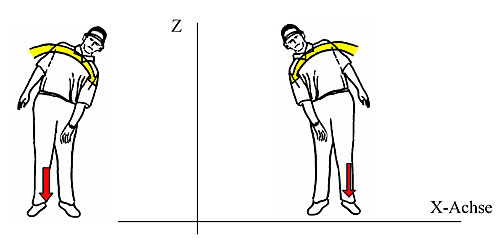 |
|
fig. 4:
During the backswing
the upper body tilts to the left
on the X- axis in the direction
of the goal.
|
Im Durchschwung kippt
the upper body tilts to the right
on the X- axis in the opposite Direction.
|
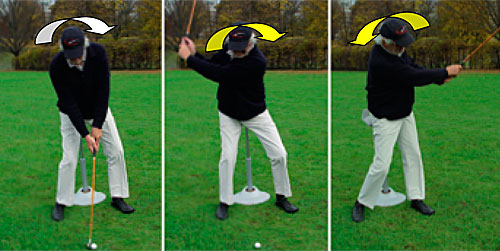 |
fig. 5:
An exercise to stabilize the static system
In order to develop a feeling for tilting, thereby retaining
the hip angle, half swings using the Swopper (a training
assistant) are a helpful exercise. |
One can clearly see how, from the addressing position, the upper
body tilts in the direction of the goal, thereby setting the
arm-club pendulum motion free for the swing. The mirror image
is valid for the follow through. Hereby, the upper body swings
around a virtual center of rotation. The Swopper is a very helpful
training assistant for this process. Swinging from the Swopper
does not allow the hip to be actively employed. Should the player
rotate out of control, he will lose his balance and will not
hit the ball correctly.
AN EXERCISE TO ACCELERATE THE DYNAMIC
SYSTEM
During the upswing, tension is developed in both broad back
muscles through the support of both neck muscles. After the
change of direction of the swing, this tension pulls the shoulder
axis against the inertia of the pendulum motion system vertically
downward. The angle between the club shaft and the arm is hereby
narrowed, leading to a high degree of kinetic energy. This principal
of obtaining such energy is used eg. when lashing a whip.
fig. 6: Shoulder tension,
narrowing the angle, whiplash effect (fig. 3). |
|
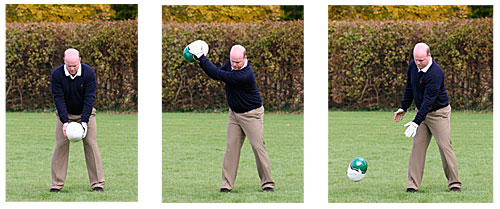 |
fig. 7:
An exercise to comprehend the
core movement of the dynamic system
In order to understand the feeling of increased tension,
hurling a ball to the ground is a good exercise. |
One can clearly see how both shoulders are lifted up to the
point of release and one feels the ball as though it were an
inert element connected to the hands through the shoulders and
arms.
It is recommended to perform this exercise within different
phases of the upswing.
This way the player experiences, between
the half and full upswing, all geometric conditions of the swing
and can tune them to the respective dynamic conditions.
Hereby
the upper arms slide up and down at the chest.
SUMMARY
Through the formation into separate phases of movement it is
possible, on the basis of the core movements, to develop a systematic
training based upon these movements, to automate partial movements
and through an optimal tuning of the partial body impulses to
the pendulum motion, fit together the total swing movement in
its entirety.
| |
|
From the address position,
tilt to the left,
freeing the pendulum motion for the
upswing.
After reversing the swing, the “whip”.
Then tilt toward the right, freeing the pendulum motion
for the follow through.
System stability slows down to the Finish. |
| fig.
8: These pictures demonstrate
how the core movements, optimally tuned to the rhythm
of pendulum motion, fit together the total swing movement
in its entirety. |
|
The player does
not need to learn to master numerous partial movements.
He just needs to learn the core movements of CARVINGGOLF
– THE CORE OF THE SWING MOVEMENT. |
Munich , 11.13.2012 / Bechler / Kreuzpaintner / Thöni /
Tusker
<<
Back to News


